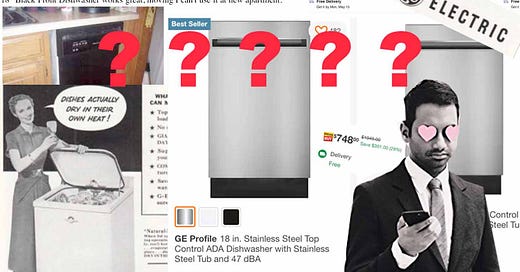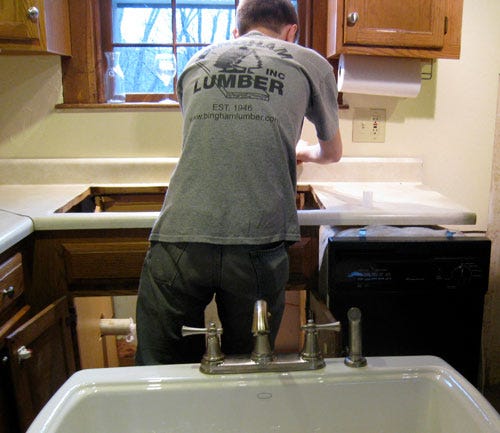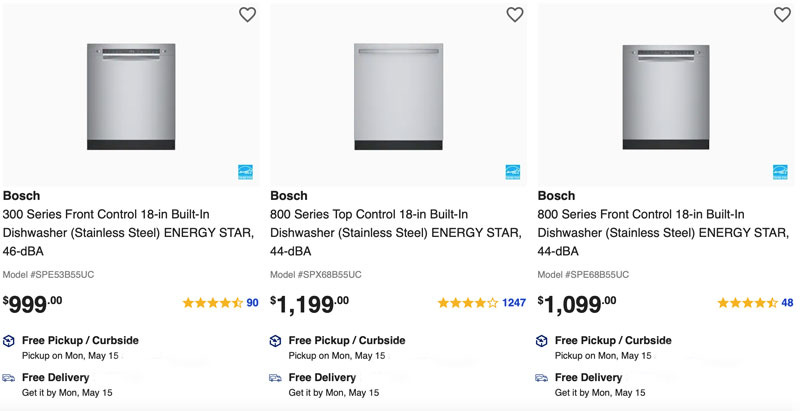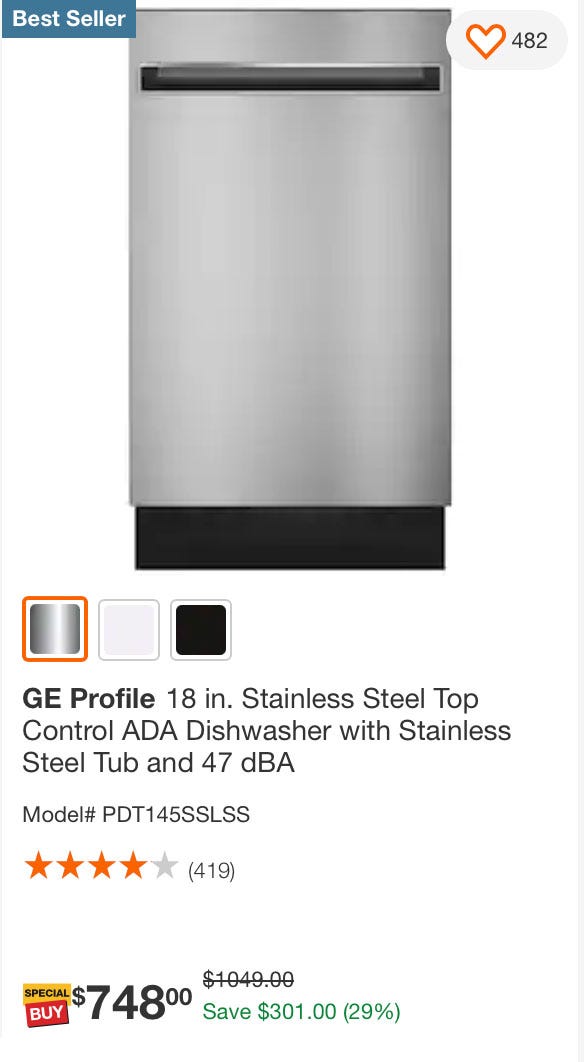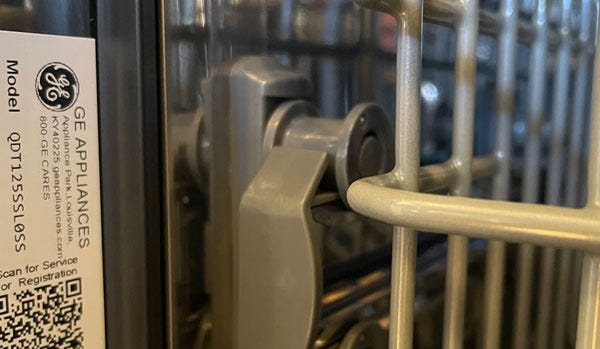Welcome to another edition of Willoughby Hills!
This newsletter explores topics like history, culture, work, urbanism, transportation, travel, agriculture, self-sufficiency, and more.
If you enjoy what you’re reading, please consider a free subscription to have this newsletter delivered in your inbox twice a week:
I bought my first dishwasher in 2009 off of Craigslist for $100.
And yes, I took a screenshot of the ad.
My wife and I had just bought our 1910 farmhouse at the exurban edge of Boston. As people that cook a lot, adding a dishwasher was high on our list of initial improvements. The house did not have one when we moved in.
Most dishwashers in the USA are 24” wide, but the only space we had for a dishwasher was an existing 18” cabinet next to the sink that we planned to remove. There are a handful of companies that make 18” dishwashers, but because of low demand, there are usually just a few models available and they’re priced much higher than a typical dishwasher.
We were young and had just bought a house, so buying a new and pricey dishwasher seemed like a luxury that we couldn’t quite justify yet. So when I found somebody selling a used 18” dishwasher for $100, I couldn’t have emailed him fast enough!
That dishwasher was simple, utilitarian, and no frills. It was a Frigidaire brand with push-buttons on the left side to set the cycle and a giant analog dial on the right to start the unit. It was basic, but it did its job.
We had that dishwasher for the next seven years until it felt like it was time to replace it. There was nothing wrong with it per se, it was just starting to look and feel a bit out of date. We were parents by then, we had a little more money, and we were ready to have something a little nicer in our kitchen.
In a testament to that Frigidaire’s longevity, when we were done with it, it didn’t go off to a landfill. I was producing Ask This Old House at the time and decided to turn it into a prop that we could use in our studio.
After serving two different households, that old $100 Craigslist dishwasher ended up appearing on national television a few times, rigged with GoPros and waterproof lighting to teach people about how dishwashers work.
When it came time to replace our old Frigidaire, I went into the local appliance store and inquired about 18” dishwashers, thinking they might have better options than the big box stores.
There were no 18” dishwashers on display to touch and feel. There were just a few models available to order: an entry level model that would be very similar to what we already had, a mid-range Whirlpool, and a higher-end unit that was over $1,000. We opted for the Whirlpool, thinking a reputable name brand would be better than the cheapest option.
The Whirlpool also lasted about seven years, until it completely failed a few weeks ago. After doing a load of dishes we found a small spring a little larger than a penny on the floor near the dishwasher. That spring seemed to keep the dishwasher door locked in place. Without the door fully locked, the machine wouldn’t run.
I looked around the whole dishwasher, trying to find where the broken spring used to attach, but to no avail. I then tried to locate a parts breakdown online that might give me a clue as to where that spring came from and how to replace it. But my web searches also came up dry. There was surprisingly little information about this unit on the web.
I was frustrated that a little metal spring that was probably worth about two dollars was disabling our entire dishwasher and I wanted everything working again.
I contemplated calling the store where I bought it and scheduling a repair service, but it could be a few hundred dollars to have a tech come out to diagnose the problem and fix it. I reluctantly began to look into replacing the dishwasher a few weeks ago.
I’ve written before about my grandparents’ Sears kit house from the 1930s. They had a gas stove and a refrigerator that dated from the 1970s for my entire life. Both were still going strong when the house was sold a few years ago after they passed.
My Whirlpool dishwasher, on the other hand, didn’t even last a full decade. I started looking into it, and it turns out that appliances these days really aren’t made to last. In a piece for Reviewed, Keith Barry put a timeline to the appliances in our homes:
“The lifespan of most appliances built today is indeed shorter than it was decades ago… The most reliable data comes from a survey the National Association of Homebuilders, conducted back in 2007. It found that the average major appliance lasts fewer than 15 years. Dishwashers last about nine years, washers and dryers about 10, and refrigerators about 13.”
Barry goes on to explain why lifespans are so short:
“In addition to broad economic factors that affect all durable goods, appliance lifespans are shorter for a few specific reasons. The first is that production of individual components is frequently outsourced to the least-expensive third-party manufacturers. Additionally, both finished products and their components are designed to weigh less, so that they’re less expensive for manufacturers to ship. Finally, tolerances are tighter, fits are closer, and electronic controls have taken the place of mechanical ones—in other words, more plastic and less metal.”
Not wanting to go through another replacement cycle anytime soon, I began to do some research into the best dishwashers for our house. I looked at the websites of big box home centers like Home Depot and Lowe’s, electronics stores like Best Buy, and my local appliance shop, which now lists inventory online.
Bosch’s 18” dishwashers immediately caught my eye because they seemed loaded with useful technology and also included a third rack. When you’re working with a smaller dishwasher, being able to cram in more dishes per cycle is a huge advantage. Bosch was considerably more expensive than other manufacturers, but I hoped that paying more up front could mean a more durable build and a longer lasting product.
I was willing to take the plunge until I looked closer at the availability. It seems that any version of the Bosch dishwasher would not arrive until May! We’re a family that cooks for nearly every meal and the thought of doing dishes by hand for another three months just didn’t seem possible.
Best Buy offered a Samsung dishwasher for $809, but it was also backorder until late March.
I went back and forth between whether I should just buy the cheapest unit for about $500 with no brand name or gamble on a brand name again. Going with Whirlpool last time hadn’t turned out all that well, and it seemed that build quality was going to be poor regardless of who made it.
I ended up finding a GE Profile dishwasher on sale at Home Depot for $748. It seemed… fine. It would probably keep my dishes clean, but it wouldn’t necessarily spark joy.
Even though I was willing to spend more than $1,000 for a fully loaded Bosch unit, there was something about spending $748 for an okay GE that just felt wrong. I ended up procrastinating for about a week, knowing that I should probably just order the GE, but being afraid to pull the trigger.
The whole experience of online appliance shopping reminded me of the online dating scene which Aziz Ansari discussed in his 2015 book Modern Romance (a book which is now older than my broken Whirlpool dishwasher).
The book opens with Ansari visiting a retirement home on the Lower East Side of Manhattan to talk with older couples about how they met. It turns out that most of the married folks had met due to proximity:
“It was remarkable. In total, fourteen of the thirty-six seniors I spoke with had ended up marrying someone who lived within walking distance of their childhood home. People were marrying neighbors who lived on the same street, in the same neighborhood, and even in the same building…
After our interviews we examined whether this spoke to a larger trend. In 1932 a sociologist at the University of Pennsylvania named James Bossard looked through five thousand consecutive marriage licenses on file for people who lived in the city of Philadelphia. Whoa: One-third of the couples who got married had lived within a five-block radius of each other before they got married. One out of six had lived within the same block. Most amazingly, one of every eight married couples had lived in the same building before they got married.”
Ansari also describes how his dad chose to marry his mother via arranged marriage:
“He told his parents he was ready to get married, so his family arranged meetings with three neighboring families. The first girl, he said, was a ‘little too tall,’ and the second girl was a ‘little too short.’ Then he met my mom. After he quickly deduced that she was the appropriate height (finally!), they talked for about thirty minutes. They decided it would work. A week later, they were married.
And they still are, thirty-five years later.”
This process of choosing a soulmate sounds remarkably similar to me visiting the local appliance showroom seven years ago. One dishwasher was too cheap, one was too expensive, so I bought the Whirlpool because it seemed just right, although I didn’t get the 35 years of longevity that Ansari’s parents did.
Since electricity came into our homes and appliances were invented, this system of shopping for limited selection locally worked fine. A salesperson shows a customer a handful of options on the sales floor, the customer chooses from one of maybe a dozen choices, and they never see that salesperson again for a few decades.

When the showroom is no longer the local appliance shop but an endless scroll of incredibly similar options, making a decision can be excruciating. I had settled on the GE dishwasher, but I still couldn’t bring myself to press “buy now.” Why not?
According to Ansari, this is a problem with having everything instantly available at our fingertips on the internet:
“Barry Schwartz is a professor of psychology at Swarthmore College who has spent much of his career studying the annoying problems that come from having an abundance of options.
Schwartz's research, and a considerable amount of scholarship from other social scientists too, shows that when we have more options, we are actually less satisfied and sometimes even have a harder time making a choice at all.”
Ansari goes on to say:
“In the 1950s the pioneering scholar Herbert Simon paved the way for people like Schwartz by showing that most of the time people are not all that interested in getting the best possible option. Generally, Simon argued, people and organizations lack the time, knowledge, and inclination to seek out ‘the best’ and are surprisingly content with a suboptimal outcome. Maximizing is just too difficult, so we wind up being ‘satisficers’ (a term that combines ‘satisfy’ and ‘suffice’). We may fantasize about having the best of something, but usually we are happy to have something that's ‘good enough.’"
When my only option was a $100 used dishwasher on Craigslist, I was perfectly content with it and it lasted for a long time. When I suddenly have every option available to me, settling can be challenging. This is especially true when the choices available all seem mediocre, pricey, and unlikely to last beyond when my elementary aged children reach high school.
It’s the same unease that comes from searching for something on Amazon and discovering dozens upon dozens of off-brand products, none of which are really what we want.
After about a week of waffling, I decided that I couldn’t live without a functional dishwasher and was ready to commit. Time to buy the $748 GE unit at Home Depot.
But before I did, I decided to do one last search just to make sure I was happy with my purchase. I had been staring at the GE listing for so long that maybe I was overlooking something else.
I typed “18” dishwasher” into Home Depot’s search bar for the hundredth time and I noticed something that I hadn’t before. Take a look:
There was another dishwasher that looked identical to the GE one I had been staring at for a week. The description was word for word the same, except it was $100 cheaper and was labelled as “Haier” brand.
I looked closer at the listing, and each photo was identical too. The only difference was the control panel in one shot had a Haier logo and on the GE page, it was a Profile logo.
It turns out that GE appliances are no longer a part of General Electric. They were sold to Chinese appliance company Haier in 2016.
According to Family Handyman, most appliance brands are part of large conglomerates. GE, Monogram, and Hotpoint are all a part of Haier. Whirlpool is the umbrella company for Maytag, Kitchen Aid, JennAir, and Amana.
While Kenmore was spun off from Sears in 2018, it had been outsourcing it’s appliance manufacturing for years, slapping a “Kenmore” label on products sold in Sears that may be branded as Amana, GE, or Frigidaire at another store. The only way to know for sure who made it is by looking at the first three digits of the model number, which is a code for the actual maker.
We decided on the Haier version that I had seen on Home Depot’s website, although we ended up ordering it from Lowe’s who had the same price. (My local appliance store lists the Haier for $73 more than the big boxes).
The new dishwasher arrived yesterday and I spent the morning installing it. As I was doing so, I noticed that even though the label on the control panel says Haier, the sticker inside the unit is for a GE. The unit was made in China.
Ironically, I ended up with a GE dishwasher after all, although I saved $100 in the process. I probably should feel more satisfied than I do, but there’s something about all of this that just leaves me feeling unnerved.
In the era of appliance showrooms and limited selection, there may have also been one unit selling under a few brand names, but it was much harder to know. Even if I may have come out unknowingly paying more under that system, I left feeling like I got what I needed.
These days, the internet makes us believe that there’s always something better out there if we just keep searching, never truly feeling satisfied.
What has your experience been with modern appliances? I’d love to hear your thoughts. Please drop a comment below!
Related Reading
What Does It Mean to be “Old”?
If you’ve missed past issues of this newsletter, they are available to read here.
If you enjoyed this issue, please share forward it to a friend or share it on social media:
Stay Safe!
Heath


